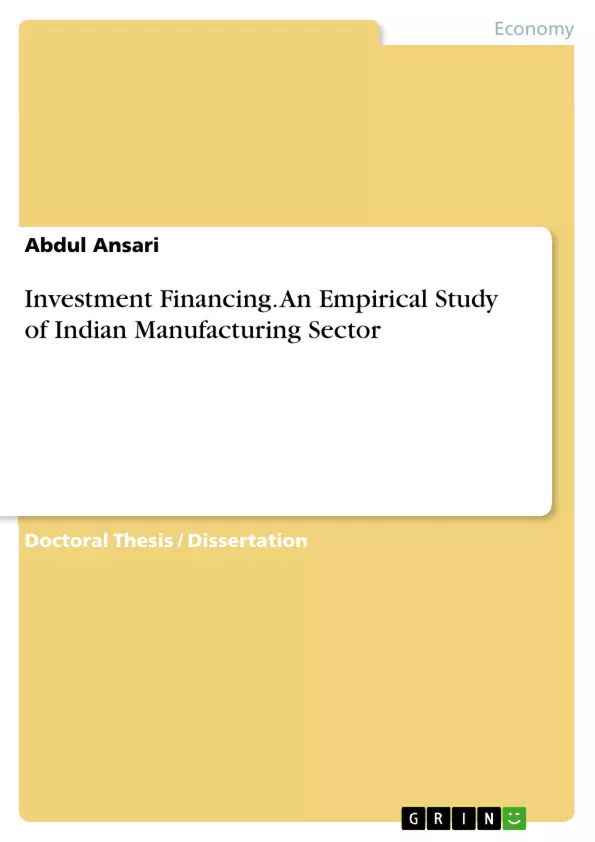This book contains, first, a broad study of Indian Manufacturing sector, its contribution in Indian national income, employment and role in industrial output and growth. Second, by using CMIE industrial panel data and latest econometric methodology, an attempt has been made to empirically investigate the investment cash flow sensitivity in the non-government manufacturing sector of India after economic reforms of 1991. This book is most suited for advanced under graduates, post graduate and research students who are pursuing research in Indian economic development and investment analysis.
Another feature of this book is the frequent presentation of statistical data in tables or graphs. These serve not only to give readers a sense of comparative analysis but also to acquaint them with possible sources for any research they may wish to undertake in Indian industrial sector themselves. Finally, this book also provides some of the short and long term problems faced by this sector which is necessary for an intelligent perusal of the Indian economic development issues.
Inhaltsverzeichnis (Table of Contents)
- INDIAN MANUFACTURING SECTOR
- An Introduction
- Internal Funds and Investment
- Perfect and Imperfect Capital Markets
- Financing Constraints and Investment
- Studies on Indian Firms Financing
- INVESTMENT THEORIES AND EMPIRICAL MODELS
- Theories of Fixed Investment Behaviour
- Empirical Investment Models
- INDIAN MANUFACTURING: COMPOSITION, PERFORMANCE AND POLICIES
- Industrial Data Compilation
- Historical Analysis
- Major Economic Reforms
- Performance of Manufacturing Sector
- Contribution of Manufacturing Sector
- Manufacturing Sector: Sources of Finance
- Corporate Sector Growth since Economic Reforms
- DATA COLLECTION, METHODOLOGY AND ANALYSIS
- Research Methodology
- Estimation Technique
- Empirical Results
- Post Reform Changes in ICFS
Zielsetzung und Themenschwerpunkte (Objectives and Key Themes)
This book aims to provide a comprehensive analysis of the Indian manufacturing sector, encompassing its role in the national economy, employment generation, and its contribution to industrial growth. The study leverages CMIE industrial panel data and advanced econometric methods to investigate the sensitivity of investment to cash flow in India's non-governmental manufacturing sector post-1991 economic reforms. This research is tailored for advanced undergraduate, postgraduate, and research students engaged in Indian economic development and investment analysis.
- The contribution of the Indian manufacturing sector to national income and employment.
- The impact of economic reforms on investment behavior in the manufacturing sector.
- The relationship between investment and cash flow sensitivity in the Indian manufacturing sector.
- The challenges and opportunities facing the Indian manufacturing sector in the globalized era.
- The role of government policies in shaping the growth and development of the manufacturing sector.
Zusammenfassung der Kapitel (Chapter Summaries)
- Chapter 1: "INDIAN MANUFACTURING SECTOR" introduces the Indian manufacturing sector as the core of the industrial sector and its crucial role in driving economic growth, employment, and inter-sectoral linkages. It delves into the historical context of the sector, its evolution under British rule, and its recent emergence as a global manufacturing hub. The chapter also examines the sector's performance in terms of output and employment, highlighting the impact of government policies and the challenges of global competition.
- Chapter 2: "INVESTMENT THEORIES AND EMPIRICAL MODELS" explores theoretical frameworks of fixed investment behavior and reviews empirical models used to study investment decisions. It lays the foundation for the empirical analysis presented in subsequent chapters.
- Chapter 3: "INDIAN MANUFACTURING: COMPOSITION, PERFORMANCE AND POLICIES" provides a detailed analysis of the Indian manufacturing sector, examining its composition, historical performance, and the impact of major economic reforms implemented since 1991. This chapter delves into the sector's growth trajectory, contribution to national output, and the sources of finance used by manufacturing firms.
- Chapter 4: "DATA COLLECTION, METHODOLOGY AND ANALYSIS" outlines the research methodology employed in the study, including the data sources, estimation techniques, and empirical results. This chapter presents the core findings of the investigation into investment cash flow sensitivity.
Schlüsselwörter (Keywords)
The study focuses on the Indian manufacturing sector, its performance, investment behavior, and the impact of economic reforms. Key terms include: investment cash flow sensitivity, manufacturing sector, economic reforms, industrial growth, employment, CMIE industrial panel data, econometric analysis, Indian economy, and global manufacturing hub.
- Quote paper
- Abdul Ansari (Author), 2018, Investment Financing. An Empirical Study of Indian Manufacturing Sector, Munich, GRIN Verlag, https://www.grin.com/document/453982



